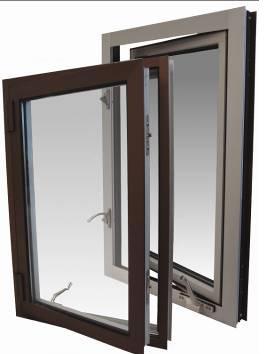Aluminum extrusions are the material of choice for window and curtainwall framing on almost all commercial and institutional building projects.
Architects' design creativity is set free by the adaptability of these aluminum products, which also support sustainable design goals in a number of ways, from low thermal transmittance to glare-free daylighting to natural ventilation.
Aluminum is the ultimate, recycled material. According to Aluminum Association statistics:
- Annual U.S. aluminum can consumption is 100 billion units, or one per day for each citizen.
- It requires only 5% of the energy to recycle aluminum as it does to smelt new aluminum.
- Using recycled aluminum instead of raw materials reduces the generation of air pollution by 95% and water pollution by 97%. (Federal Green Construction Guide for Specifiers, http://www.wbdg.org/design).
- Because of recycling, over two-thirds of the aluminum ever smelted is still in use.
- 90% of the aluminum in buildings gets recycled upon demolition.
- One case of un-recycled cans wastes the amount of energy in one gallon of gas.
- Cans are on average, back in use 60 days after recycling.
- The aluminum industry has cut carbon emissions by 53% in the last 15 years.
Window and curtainwall manufacturers have always recycled virtually 100% of the aluminum scrap generated in their own processes, including obsolete and damaged materials, saw drops, miter slugs, chips and punching blanks.
GREEN BUILDING
 The U.S. Green Building Council LEED® 2009 Rating SystemTM for New Construction and Major Renovation (LEED-NC) Version 3 is clear in its requirements for credits related to recycled content.
All of Wausau's window and curtainwall products are available with:
-Aluminum extrusions, exclusively from secondary billet, that
contain at least 70% total recycled content
-Paints that can be specified with post-industrial waste
-Eco-friendly anodizing using acid etch technology for reduced
landfill waste
-Glass, steel and hardware components that that are
composed of high percentages of recycled content
Warranty provisions for window assemblies, finishing (both painting and anodizing), durability, and structural integrity are unaffected by the use of secondary billet that is free of contaminants, meeting Aluminum Association alloy content limits.
LEED® 2009 Materials and Resources (MR) Credits 4.1 and 4.2 require separate reporting for pre-consumer and post-consumer recycled content. These are used to calculate "combined" recycled content, equal to post-consumer plus one-half of pre-consumer recycled content.
Current recycled content data for Wausau's extruder-partners is shown in the following table:
Wausau's Recycled Aluminum Extrusion Content |
LEED® "Combined" Content |
Total Recycled Content |
Pre-Consumer (Post-Industrial) |
Post-Consumer |
42% to 69% |
70% to 83% |
24% to 65% |
10% to 58% |
Any specific project's recycled content depends on extrusion source(s) |
Pre-consumer recycled material is defined in LEED® 2009 Version 3 as, "...process waste that an industry has sold or traded with another through the marketplace... [but] does not include in-house industrial scrap or trimmings, which are normally fed back into the same manufacturing process." Post-consumer material is defined as, "...consumer waste, much of which comes from residential curbside recycling programs... Other post-consumer feedstock is generated when construction and demolition debris is recycled."
 Under LEED®, the recycled content value of a manufactured assembly is determined by weight. This becomes important when determining the recycled content of window and curtainwall systems, versus individual components such as framing or glass. For example, one typical project's factory-glazed window system was found to contain, by weight:
23% Aluminum extrusions
69% Insulating glass
3% Steel anchors and
reinforcing
3% Aluminum sheet trim
2% Hardware, paint, elastomers, etc.
The recycled fraction as a weighted average for all materials is then applied to the assembly cost to assess the value of all materials in a given building project applying for LEED certification.
The General Contractor's AIA or CSI Schedule of Values is the only acceptable basis for cost determination. Since exterior envelope products can be subcontracted to several different firms, this final cost-based calculation is done by the project's LEED Accredited Professional (LEED-AP), not by building product manufacturers.
Wausau provides easy-to-use templates, available on every project, detailing recycled content of components and assemblies.
REGIONAL MATERIALS
LEED MR Credits 5.1 and 5.2 "Regional Materials - 10% or 20% Extracted, Processed and Manufactured Regionally" was revised starting with LEED-NC Version 2.2., to give credit for any material that is extracted or recovered within 500 miles of the job site. Recycled aluminum used by Wausau's extruder-partners is cast into secondary extrusion billet in several locations. If the "cast house" and the job site are both within 500 miles of Wausau, Wisconsin, framing fabricated from recycled aluminum may help projects qualify for MR Credits 5.1 and 5.2 "Regional Materials."
|